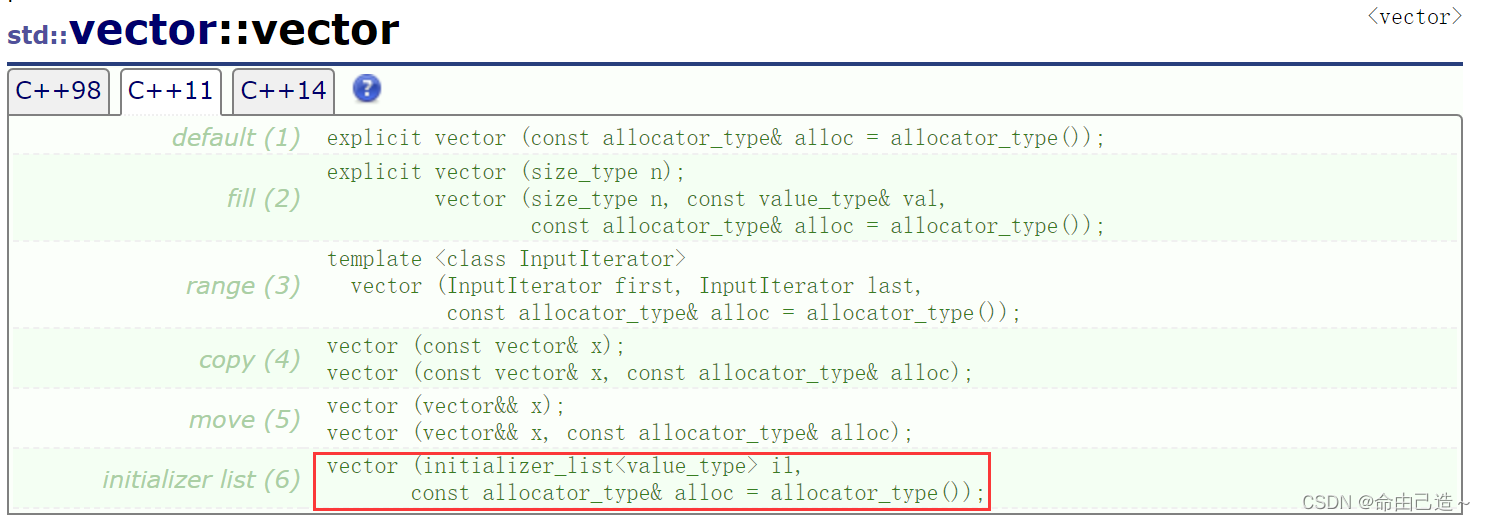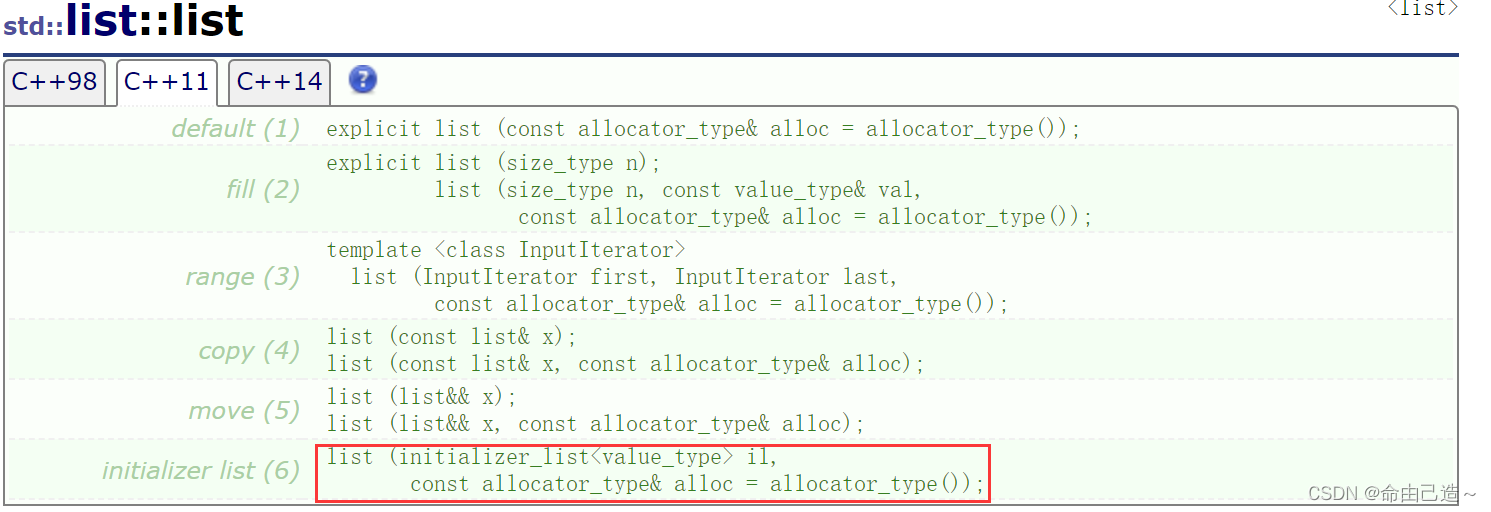文章目录
一、列表初始化
1.1 {}初始化
C++11 引入了一个新的初始化方式, 称为初始化列表(List Initialize), 具体的初始化方式如下:
初始化列表可以用于初始化结构体类型, 例如:
struct Test
{
int _a;
double _b;
};
int main()
{
Test tOld = {
1, 1.1 };
Test tNew{
2, 2.2 };// 列表初始化
int a = 1;
int b = {
1 };// 列表初始化
int c{
1 };// 列表初始化
int arr1[] = {
1,2,3 };
int arr2[]{
1,2,3 };// 列表初始化
return 0;
}
以前{}只能用来初始化结构体和数组,而现在一切皆可用列表初始化。
当然new操作符也可以使用{}初始化:
int* ptr1 = new int[] {
1, 2, 3};
Test* ptr2 = new Test[]{
{
1, 1.1}, {
2, 2.2} };
对于自定义类型{}会调用它的构造函数初始化:
class Date
{
public:
Date(int year, int month, int day)
{
_year = year;
_month = month;
_day = day;
std::cout << "Date(int year, int month, int day)" << std::endl;
}
private:
int _year;
int _month;
int _day;
};
int main()
{
Date d1(1, 2, 3);
Date d2{
1, 2, 3};
return 0;
}

其他一些不方便初始化的地方使用, 比如stl的初始化, 如果不使用这种方式, 只能用构造函数来初始化, 难以达到效果 。
int main()
{
std::vector<int> v={
1, 2, 3, 4, 5 };// 列表初始化
std::list<int> lt{
1, 2, 3, 4, 5, 6 };// 列表初始化
for (auto& e : v)
{
std::cout << e << " ";
}
std::cout << "\n";
for (auto& e : lt)
{
std::cout << e << " ";
}
std::cout << "\n";
return 0;
}

这里明显不是使用构造函数初始化的
那么这里是怎么做到的呢?
利用std::initializer_list类型。
1.2 initializer_list类型
int main()
{
auto tmp = {
1, 2, 3, 4 };
std::cout << typeid(tmp).name() << std::endl;
return 0;
}

typeid(变量名).name() 查看变量的类型
我们可以把它理解为一个存在常量区数组。
这个容器有以下接口:

这样我们就可以像迭代器一样使用这个容器。
所以vector和list就可以这样初始化:


其实使用initializer_list初始化就是遍历initializer_list的内容然后一个一个插入。
vector(initializer_list<T> il)
:_start(nullptr)
, _finish(nullptr)
, _endofstorage(nullptr)
{
reserve(il.size());// 防止过度扩容
typename initializer_list<T>::iterator it = il.begin();
while (it != il.end())
{
push_back(*it);
++it;
}
}
二、类型推导
2.1 auto
auto的作用就是自动推导对象的类型。从这个意义上讲,auto并非一种"类型"声明,而是一个类型声明时的"占位符",编译器在编译时期会将auto替换为变量实际的类型。
double foo()
{
return 1.1;
}
struct Test
{
};
int main()
{
// 内置类型
int a = 1;
auto b = a;// int
auto c = foo();// double
// 自定义类型
Test test;
auto ret = test;// struct Test
return 0;
}
2.2 auto注意事项
1️⃣ 首先定义变量的时候一定要初始化
auto a;// error
a = 10;
2️⃣ 不能作为函数的形参
void func(auto a) {
}// error
3️⃣ 变量不能作为自定义类型的成员变量
struct Test
{
auto a = 1;// error
};
4️⃣ 不能是auto数组
auto arr[] = {
1, 2, 3 };// error
5️⃣ 模板实例化类型不能是auto类型
std::vector<auto> v;// error
2.3 decltype
关键字decltype将变量的类型声明为表达式指定的类型。我前面用的typeid(x).name()可以拿到x类型的字符串,但是不能使用这个再去定义一个变量。
而decltype却可以拿到变量,后面还可以继续使用这个类型定义出变量。
int main()
{
int x = 0;
decltype(x) a = 10;// int
double y = 0.0;
decltype(x + y) b;// double
return 0;
}
三、新增与改进
3.1 nullptr
nullptr 是为了解决原来 C++中 NULL 的二义性问题而引进的一种新的类型,因为NULL既能表示整型也能表示指针。
#ifndef NULL
#ifdef __cplusplus
#define NULL 0
#else
#define NULL ((void *)0)
#endif
#endif /* NULL */
3.2 范围for
在 C++中 for 循环可以使用基于范围的 for 循环,示例代码如下:
int main()
{
int a[] = {
1, 2, 3, 4, 5, 6 };
for (int& e : a)
{
std::cout << e << " ";
}
std::cout << '\n';
return 0;
}
3.3 array
template < class T, size_t N > class array
array就是个数组,它跟vector的区别是array是静态数组,不能扩容。
那么它跟普通数组有什么区别呢?
普通的数组对越界的检查是随机的,如果越界可能不会报错,但是array一定能检查出来。
int main()
{
int a1[10];
a1[22];// 不报错
std::array<int, 10> a2;
a2[22];// 报错
return 0;
}
3.4 forward_list
template < class T, class Alloc = allocator<T> > class forward_list
forward_list就是一个单链表,它只有头插和头删接口,并没有尾插和尾删接口。
int main()
{
std::vector<int> a = {
1, 2, 3, 4, 5, 6 };
std::forward_list<int> lt(a.begin(), a.end());
for (auto& e : lt)
{
std::cout << e << " ";
}
std::cout << '\n';
return 0;
}
3.5 unordered系列
这个在之前的文章有详细介绍:
【C++】哈希
跟map与set相比效率得到了大提升。
3.6 final与override
这里在多态里面有过详细介绍:
【C++】多态
final关键字在父类修饰虚函数,表示该虚函数不能再被重写。
override在子类修饰虚函数,检查子类是否重写,如果没有重写则编译报错。